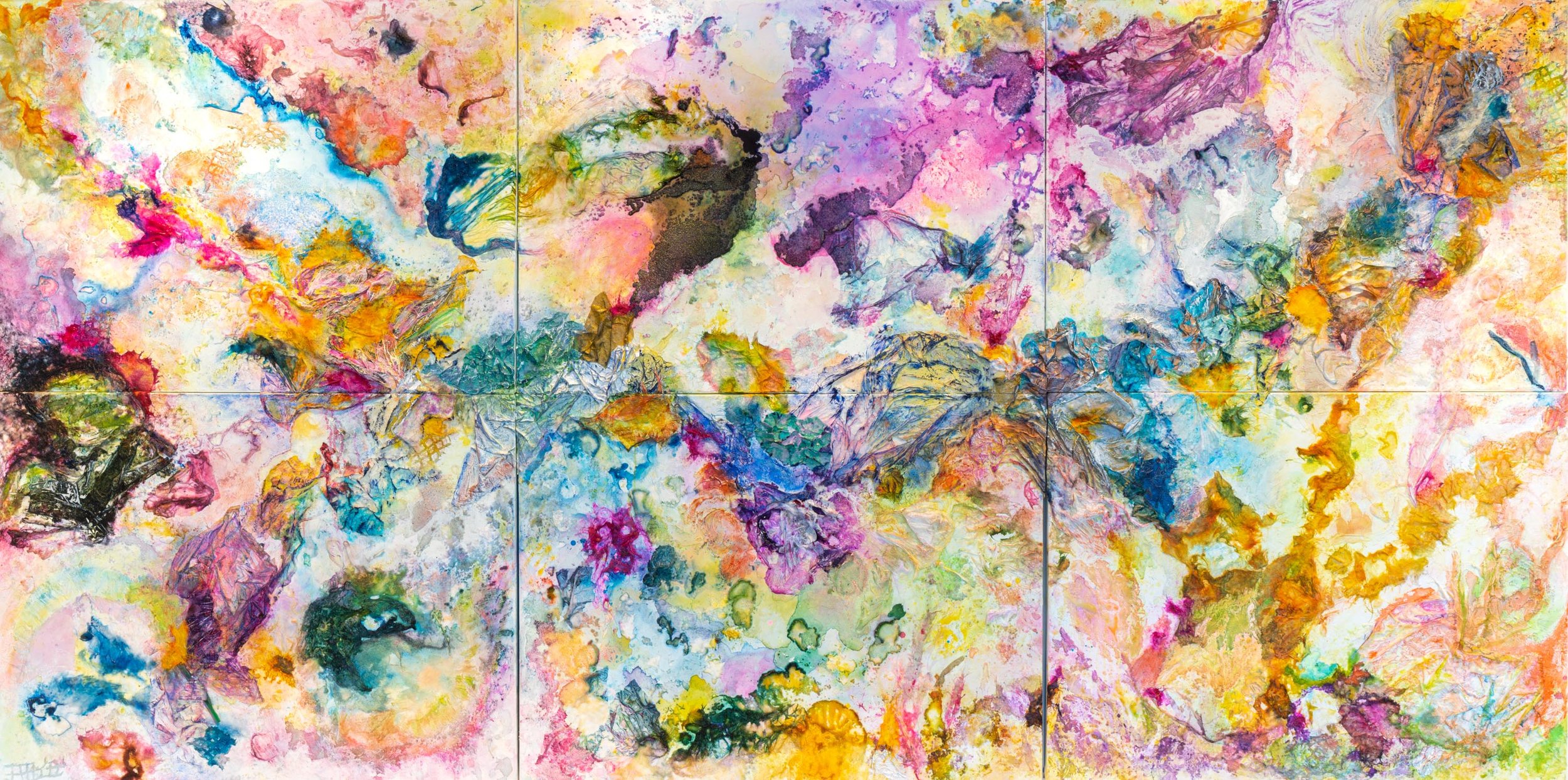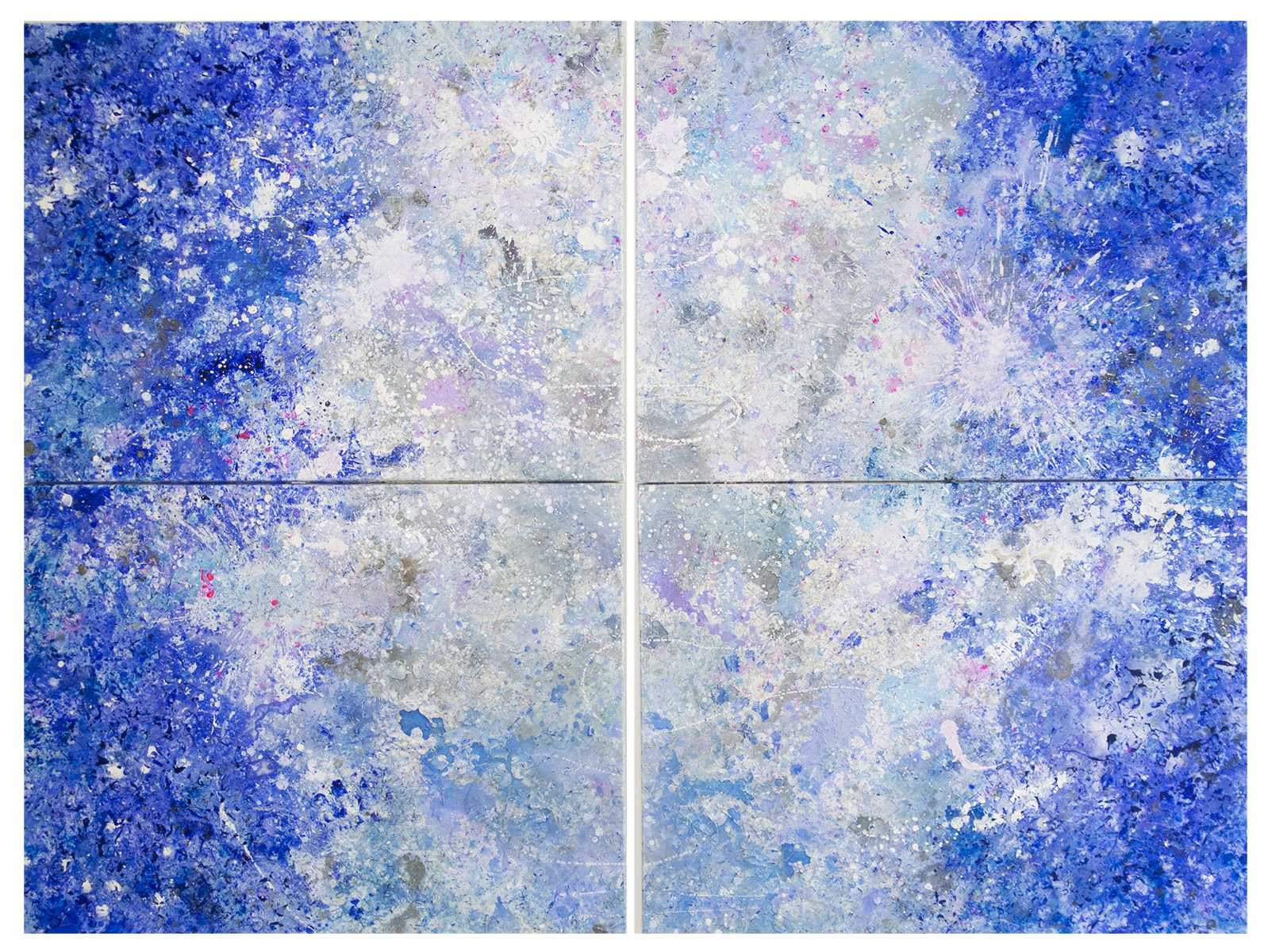About the Series
Heavily textured and radiating with energetic motion, this series illustrates one of nature’s greatest ethereal moments: the Aurora Borealis.
When the sun’s solar winds become entwined with the poles of Earth’s magnetic field, electrifying streams of light emerge like ribbons, appearing to dance and twist across the sky. The scene is almost dreamlike; it’s magical and breathtaking.
Wanting to capture the essence of this natural phenomenon, I created the Aurora Borealis series, a body of work that has an other-worldly feel. I use dynamic gestures with giant splashes of color—often defined by exploding pools of purples, pinks and blues—to symbolize feelings of excitement that come with exploring my creative spirit. Like the Aurora Borealis, when I create, my spirit soars, sweeps, sparkles, and is unafraid to shine.
Coral Reef Series
Studying a changing earth, sky, and sea
My recent work explores the use of texture, form and color to examine the eco challenges facing the world and the impact of climate change on our earth and sea.
My eco practice has developed to a complex interplay of watercolor, oil paint, and acrylic mediums, together with various paper collage and plastic materials. Through the use of new applications, drying techniques, and materials, I have uncovered practices that connect my materials to a philosophical spirit about protecting the environment. I have negotiated an "alliance" between my materials and the subject matter itself. My work has advanced from being merely illustrative to structurally aligning it to eco-based themes. The work is becoming more open, fluid, and reflective of the aqueous effects of water as well as the debris that clutters it.
These new techniques have given me the freedom to explore the world's largest organism and complementary biosphere, CORAL REEFS. These amazing super-organisms have become the language in which I communicate as an artist. As a diver and self-proclaimed “eco warrior,” I see the world through a lens of underwater coral and sea life. The shapes, colors and movement are central to my work, and are designed to raise awareness about the threats to this natural wonder.
The Dreamscape Series, originally inspired by a family sailing trip in the Far North of New Zealand, has grown to signify my wonderment of the sea: a seemingly limitless body that cradles the Earth, home of much undiscovered life. My husband and son are passionate about fishing so we have spent many family vacations on the water. I became a certified scuba diver on the Great Barrier Reef in Australia about ten years ago and our fabulous dives further inspired my enchantment with the ocean, the creatures that inhabit it, and the overwhelmingly beautiful topography of coral reefs.
Featuring hazy tones like blues, pinks and purples, and iridescent pigments, like pearls and metallics, Dreamscapes depict a graceful journey through reef beds and the open water via highly textured patterns, dramatic marks, and cooler colors.
As art critic Donald Kuspit writes, “Reading Jill Krutick’s statements about her many series…the one that strikes me as most relevant for an understanding of her oeuvre as a whole, is her ‘love for the ocean in all its glory.’ … Krutick is a remarkably fertile painter, and lively water is her expressive medium, as her oceanic experience suggests. Her art endlessly dwells on it, distills its aesthetics. It is unforgettable, and she seeks it out again and again, for it is the catalyst of her creativity, and the expression of her feminine originality.”
The Shangri La series was born out of my passion for creating dream-like settings, similar to the ones my family and I visited during our eco-adventure trips in Antarctica, the Galapagos Islands, Hawaii, Belize, and others.
My Shangri La works have deep roots in the abstract landscape tradition of Monet. The materials employed to create Shangri La-styled works often vacillate between oil and acrylic, but all contain ample texture and primary colors denoting trees or leafy formations.
After an intense career on Wall Street and in the corporate media world, I yearned to find a peaceful place within myself, allowing me to gradually transition into my new life as an artist. Painting idyllic, imaginary places like Shangri La became an escape for me—a place to explore, get lost, and recenter myself. The iterative process of layering and finding a balanced blend of colors and textures has become a meditative exercise. I hope Shangri La brings viewers a sense of solace the way it has done so for me.
Art historian Annette Blaugrund explains, “The paintings in the Shangri La series by Jill Krutick are harmonious and calming. Because of the titles given by the artist they evoke a mystical, imaginary dreamland. The viewer is transported into an explosion of gentle colors reminiscent of fallen blossoms, a gathering of petals, and star-filled skies.”
The Swirl series encapsulates all facets of my artistic interests and abilities: music, storytelling, and pop culture.
Communicated through texture, movement, and color, the Swirl series captures my childhood doodles, a fantastical interpretation of places my family has visited on eco-adventures, as well as iconic music, movies, songs, and books that have touched me during my dynamic career as a media analyst/executive and as a mother.
The Swirl series method begins by applying thick layers of oil paint to the canvas and/or carving molding paste into the canvas with grand, eddying gestures. Once applied, the paint is allowed time to dry. Angles and shapes are then inscribed onto the exposed skin of the layers via a palette knife—my favorite instrument for etching the body of each piece. Colors are meticulously added to accentuate the narrative and build tension in the canvas.
As Bruce Helander describes, “Jill Krutick has mastered the essence of lyrical abstraction when it comes to evaluating the difference between a modestly acceptable picture and a truly engaging and exciting composition that’s full of rhythm and blues.”
Abstract Landscapes represent an early style of my creative portfolio and stem from my fascination with the natural world and love for Monet and Van Gogh. Since the beginning, I always sought to depict the same kind of tenderness and candor of the outdoors with which these masters achieved. This aspiration laid the bedrock for my abstract landscape works.
Though my abstract landscape paintings began exclusively in oil paint, these modern pieces now include acrylic media too. I apply the paints using brushes, palette knives, sponges, cloths and vessels of all sizes.
My abstract landscapes typically depict the contrast between light and dark tones, contain a central horizon line, and feature either the ocean or trees. Additional landscape elements and shapes are meticulously added to illuminate the unique character of each narrative.
Each landscape depicts a moving story, sometimes guiding the viewer through a mystical, watery setting. As art critic Donald Kuspit says, “It is the creative power implicit in Krutick’s imaginative response to nature’s innate aesthetics…One might say she abstracts the creative flow of nature from its material manifestation in moving water, treating it as an aesthetic phenomenon in itself.”
While the essence of my abstract landscapes is constantly evolving, the core elements of these works are also reflected in my other artistic styles like the Shangri La series, Dreamscape series, and Aurora Borealis series.
The Ice Cube shape has emerged as my artistic fingerprint — triumphantly expressing the human spirit through adversity.
The Ice Cube series represents the process involved in overcoming personal challenges. I often equate the use of geometric shapes to setting “boundaries” or, conversely, being “boxed in.” The molten gold in the middle of many of my Ice Cube works represents the fire from within to overcome a battle capable of melting the boundaries of the cube. Drips on the canvas symbolize the fragments of the obstacle that remain and the memories now inscribed in my story.
It is not a coincidence that my Ice Cube paintings highlight an equal sign. Equilibrium is essential for one to fairly and completely navigate through a problem. While the shape may appear simple, the canvas comes alive with the dynamic textures, shading, and embellishments with which I dress each work. Variety is the spice that defines every Ice Cube, much like every challenge is defined by a unique set of issues.
As art critic Donald Kuspit writes, “…of course an ice cube is a solid that becomes liquid — Krutick’s paintings are invariably liquid, that is, are always in “flow,” to use the psychologist Mihaly Csikszentmihalyi’s term.” Art historian, Annette Blaugrund, calls the “Ice Cube pictures ... an interesting evolution of geometric forms suggestive of Mark Rothko’s rectangular fields of color.”
The Geometric Series marks the beginning of my professional career as an artist. My first geometric work emerged in 1993 with Walking on Sunshine, a plein air landscape inspired by a delicious summer day. The vertical and horizontal marks displayed in my geometric works originate from my work as a financial analyst—a rigid lifestyle governed by mathematics, strategy, and algorithms. After closing my chapter on Wall Street and the corporate world, my geometric paintings provided me with a comfortable platform to reflect on old routines and regain my artistic strength.
As you will see in many of my geometric works, I often employ an eclectic color palette to complement the repetitive patterns displayed on the canvas. This practice is designed to convey the multi-dimensional, dichotomous nature of the corporate world: Vibrant yet dull. Predictable yet serendipitous.
Art historian Annette Blaugrund explains, “As with many second and third generation abstract expressionists, Krutick utilizes elements of chance that are personal, emotional, and unpredictable. Using palette knife, brush, as well as sometimes flinging paint at a canvas on the floor, she is able to delineate form through the texture of the paint … and by creative color choices. Even when she obliterates the lines made by the palette knife by smoothing them over with the flat side of the knife … the overall effect is that of dense vegetation with blue water and/or sky peeking through. Later works have the sensibility of patchwork quilts of brilliant color … suggestive of the colors and structure of Hans Hoffman’s paintings.”








